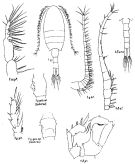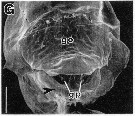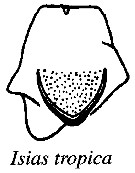|
|
 |
Fiche d'espèce de Copépode |
|
|
Calanoida ( Ordre ) |
|
|
|
Diaptomoidea ( Superfamille ) |
|
|
|
Centropagidae ( Famille ) |
|
|
|
Isias ( Genre ) |
|
|
| |
Isias tropica Sewell, 1924 (F,M) | |
| | | | | | | Ref.: | | | Sewell, 1924 (p.782, figs.F,M); Kasturirangan, 1963 (p.37, figs.F,M); Bayly, 1964 b (p.243, 244:Table 1, 2); Silas, 1972 (p.648); Pillai P., 1975 a (p.320, 325, Table 1, fig.M); Barthélémy & al., 1998 (p.721, genital area); Barthélémy, 1999 a (p.9, Fig.9, G) |  issued from : Sewell R.B.S. in Mem. Ind. Mus., 1924, 12. [Plate XLIV, Fig.1]. Female & Male (from Chilka Lake). Nota Female: Proportional lengths of the cephalothorsx and abdomen are 47:21. Head and 1st thoracic segment separate, 4th and 5th partially fused, but the line of demarcation between them can be detected. Proportional lengths of urosomites and furca as 50:21:29:38. Genital aperture protected laterally by a curved plate, the margins of which armed with 3 small backwardly directed spines. Caudal rami 3.5 times as long as broad, and bear 5 apical setae. A1 22-segmented (segments 8-9, 11-12 and 24-25 fused); 1st segment with a long curved spine. P5 with exopod 2-segmented and a rudimentary endopod that is fused with the 2nd basal segment; the 1st exopodal consists of two segments (exopod 1 and 2) that are fused together and on its inner margin distally, from that part of the segment corresponds to exopod 2, arises a stout, slightly curved spine that is finely serrated along both margins; the terminal segment of the exopod bears 2 marginal spines and an end-spine, and 4 delicate setae spring from its inner border; the endopod forms a conical projection that terminates in a single seta. Nota Male: Proportional lengths of urosomites and furca as 23:30:26:20:20:26. No projecting process on the right side of the 3rd abdominal segment, but there is a small round projection crowned with small spines on the right side of the 2nd segment. A1 asymmetrical; left resembles that of the female, 22-segmented, the 1st segment bears a curved spine on its anterior aspect (as in the female); the right forms a grasping organ and the knee-joint situated between segments 18 and 19; segments 7-8, 19-21 and 24-25 fused.; segments 15 and 16 each bear a slender spine on the anterior border near the middle of their length, segment 16 also bears near its distal end a sickle-shaped spine that is furnished on its posterior border with a row of fine needle-like spines; segments 18 and 19 with tooth-plate. P5 asymmetrical; In each the exopod 2-segmented, endopod fused with the 2nd basal segment; on the right side, the 2nd basal segment bears a small spine near its distal external angle and the conical process on its inner margin (rudiment of endopod) terminates in a single small seta; on the left side, the 2nd basal segment is produced internally to a rounded point which bears two recurved claws and distally its inner margin its produced in an elongate process that represents the endopod; the distal exopodal segment bears on its outer margin 4 setae and its apex is bilobed.
|
 issued from : R.-M. Barthélémy in Thèse Doct. Univ. Provence (Aix-Marseille I), 1999. [Fig.9, G]. Female (from Thailand): G, external ventral view genital double-somite. go = genital operculum; gp = gonoporal plate. Note the pad on posterior margin of the genital operculum (arrowed)..
|
 issued from : R.-M. Barthélémy, C. Cuoc, D. Defaye, M. Brunet & J. Mazza in Phil. Trans. R. Soc. Lond., B, 1998, 353. [p.733, Fig.63]. Schematic representation of external genital area in the species studied; Dashed line, limit of the anterior pad and lateral thickenings; shading, posterior pad; dots, genital operculum.
| | | | | Ref. compl.: | | | Sewell, 1932 (p.233); 1948 (p.429); Dussart & Defaye, 1983 (p.12); Kazmi, 2004 (p.228); Shanthi & Ramanibai, 2011 (p.132, Table 1) | | | | NZ: | 1 | | |
|
Carte de distribution de Isias tropica par zones géographiques
|
| | | | | | | Loc: | | | Arabian Sea (Pakistan), Bay of Bengal (coastal), Chilka Lake, Cochin Harbour, Tailand
Type locality: 19°45'N, 85°30'E. | | | | N: | 6 (Indian: 6) | | | | Lg.: | | | (80) F: 1,26; (334) F: 1,25; M: 1,25; (1155) F: 1,26; M: 1,16; {F: 1,25-1,26; M: 1,16-1,25} | | | | Rem.: | espèce littorale, saumâtre.
Voir aussi les remarques en anglais | | | Dernière mise à jour : 06/01/2015 | |
|
|
 Toute utilisation de ce site pour une publication sera mentionnée avec la référence suivante : Toute utilisation de ce site pour une publication sera mentionnée avec la référence suivante :
Razouls C., Desreumaux N., Kouwenberg J. et de Bovée F., 2005-2026. - Biodiversité des Copépodes planctoniques marins (morphologie, répartition géographique et données biologiques). Sorbonne Université, CNRS. Disponible sur http://copepodes.obs-banyuls.fr [Accédé le 13 janvier 2026] © copyright 2005-2026 Sorbonne Université, CNRS
|
|
 |
 |






